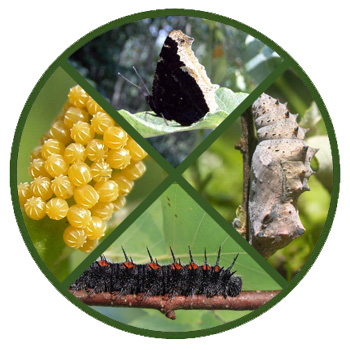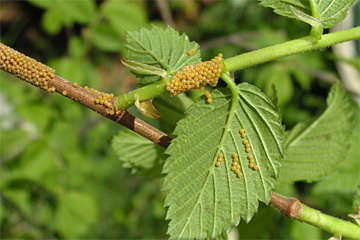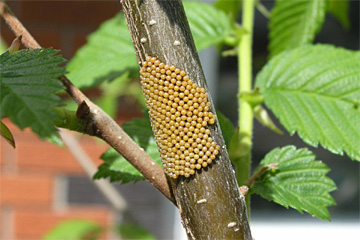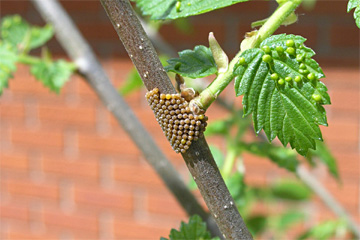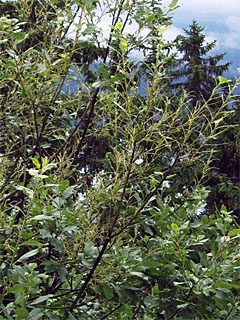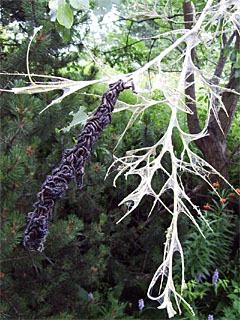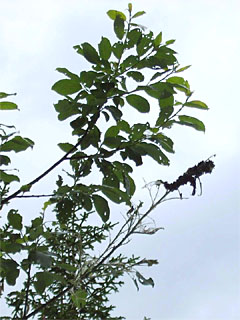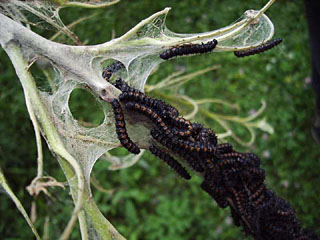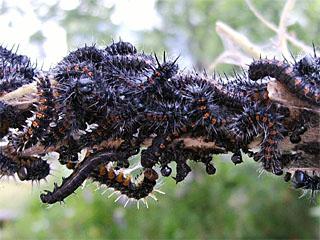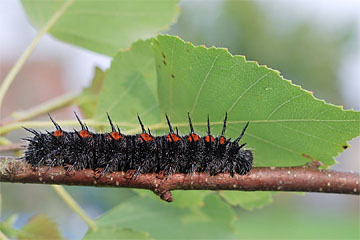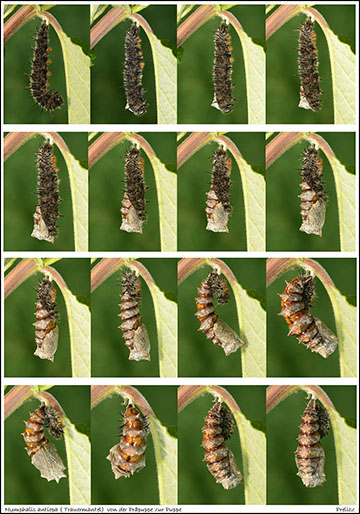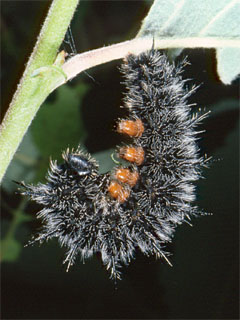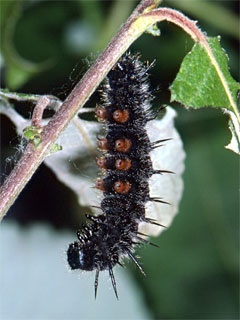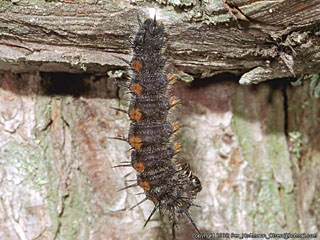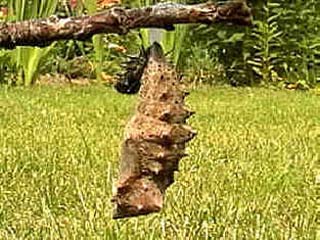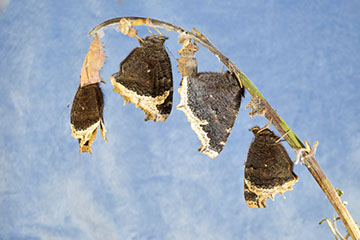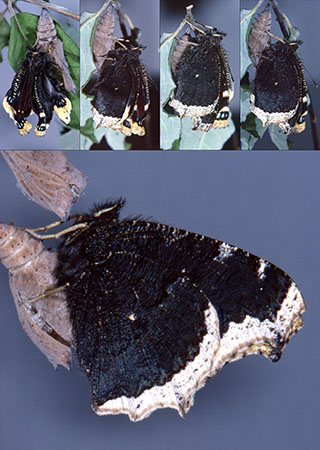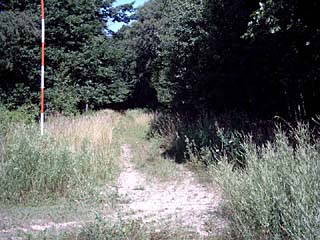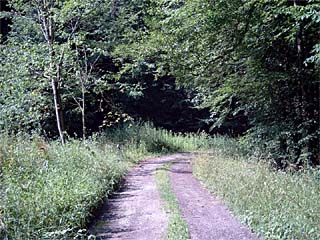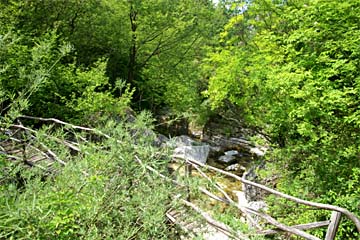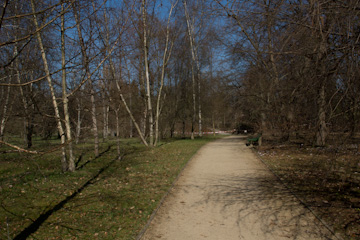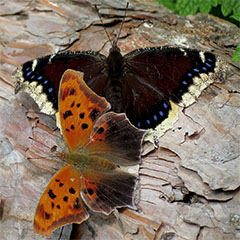The  Camberwell BeautyNymphalis antiopa (Linnaeus, 1758)Mourning CloakCamberwell Beauty is annual; univoltineone brooded in Europe and Asia, and annual; univoltineone brooded or bivoltinetwo-brooded in America, depending on the area.
Camberwell BeautyNymphalis antiopa (Linnaeus, 1758)Mourning CloakCamberwell Beauty is annual; univoltineone brooded in Europe and Asia, and annual; univoltineone brooded or bivoltinetwo-brooded in America, depending on the area.
A annual; univoltineone brooded  Camberwell BeautyNymphalis antiopa (Linnaeus, 1758)Mourning CloakCamberwell Beauty spends on average (Settele, 1999 - Die Tagfalter Deutschlands):
Camberwell BeautyNymphalis antiopa (Linnaeus, 1758)Mourning CloakCamberwell Beauty spends on average (Settele, 1999 - Die Tagfalter Deutschlands):
- 19 days as an egg
- 45 days as a caterpillar (between 32 and 50 days)
- 17 days as a chrysalis (between 12 and 22 days)
- 300 days as a imago (between 280 and 320 days)
| Egg | Caterpillar | Chrysalis | Imago | |||||
|---|---|---|---|---|---|
| 19 | 45 | 17 | 300 | ||
The timing of the beginning and end of a developmental stage (egg, caterpillar, chrysalis, adult butterfly/imago) is highly variable and depends on a variety of factors. These include, for example, temperatures/weather conditions. These can vary greatly even on a small scale and thus lead to significant deviations.
For this reason, the following information is only a rough guide.
The biotopes in which the  Camberwell BeautyNymphalis antiopa (Linnaeus, 1758)Mourning CloakCamberwell Beauty spends time feeding or mating may differ from the biotopes in which the female lays her eggs Roer, 1981 - Massenwechsel-Untersuchungen an einer Südosteuropäischen Population von Nymphalis antiopa (Lep.: Nymphalidae).
Camberwell BeautyNymphalis antiopa (Linnaeus, 1758)Mourning CloakCamberwell Beauty spends time feeding or mating may differ from the biotopes in which the female lays her eggs Roer, 1981 - Massenwechsel-Untersuchungen an einer Südosteuropäischen Population von Nymphalis antiopa (Lep.: Nymphalidae).
However, the host plant alone does not make a biotope suitable for oviposition: Other factors, such as climatic or geomorphological conditions, also play an important role.
Plants are therefore preferably selected in cooler, wetter places (e.g. north-west facing slopes or cool meadow valleys with rivers or streams). The plants are usually separated from the forest mantle or stand alone in grassland Weidemann, 1988 - Naturführer Tagfalter Band 2 - Biologie-Ökologie-Biotopschutz or along ditches Roer, 1981 - Massenwechsel-Untersuchungen an einer Südosteuropäischen Population von Nymphalis antiopa (Lep.: Nymphalidae).
 Camberwell BeautyNymphalis antiopa (Linnaeus, 1758)Mourning CloakCamberwell Beauty
Camberwell BeautyNymphalis antiopa (Linnaeus, 1758)Mourning CloakCamberwell Beauty
Eggs of Camberwell Beauty (Nymphalis antiopa) (Nymphalis antiopa ssp. hyperborea) at American Elm (Ulmus americana)
[Breeding image]
Breeding: Joseph BelicekJoseph Belicek
 Camberwell BeautyNymphalis antiopa (Linnaeus, 1758)Mourning CloakCamberwell Beauty
Camberwell BeautyNymphalis antiopa (Linnaeus, 1758)Mourning CloakCamberwell Beauty
Eggs of Camberwell Beauty (Nymphalis antiopa) (Nymphalis antiopa ssp. hyperborea) at American Elm (Ulmus americana)
[Breeding image]
Breeding: Joseph BelicekJoseph Belicek
In  Turkey
Turkey Turkey, the female prefers to lay her eggs on lower branches that face away from the sun and protrude above the water of a stream or river Hesselbarth, 1995 - Die Tagfalter der Türkei unter Berücksichtigung der angrenzenden Länder.
Turkey, the female prefers to lay her eggs on lower branches that face away from the sun and protrude above the water of a stream or river Hesselbarth, 1995 - Die Tagfalter der Türkei unter Berücksichtigung der angrenzenden Länder.
Jürgen HensleJürgen Hensle drew my attention to the reasons for the different egg-laying strategies (Source: Jürgen Hensle, pers. comm., 2006):
The laying of eggs in cool, humid places is due to the fact that the caterpillar thrives particularly well under intense, but not too hot, sunlight. This behaviour is motivated by dry, warm summers in areas with a Types of climate outside the tropics that are characterised by large seasonal fluctuations in monthly average temperatures of over 20 °C. Source: Wikipedia.continental climate.
Whether a female lays in the shade or in the sun seems to depend on the local climate and the weather conditions at the time of laying.
Under cool and humid conditions, it tends to lay its eggs on the sunny side of a bush, and under dry and warm conditions, in the shade. This is why the caterpillars are usually found in the sun in central and northern Europe, while in southern Europe or, for example, in  Turkey
Turkey Turkey, they are more likely to be found in the shade. In general, however, they prefer to lay their eggs in a cool, moist location, e.g. above a stream.
Turkey, they are more likely to be found in the shade. In general, however, they prefer to lay their eggs in a cool, moist location, e.g. above a stream.
 Camberwell BeautyNymphalis antiopa (Linnaeus, 1758)Mourning CloakCamberwell Beauty
Camberwell BeautyNymphalis antiopa (Linnaeus, 1758)Mourning CloakCamberwell Beauty
Eggs of Camberwell Beauty (Nymphalis antiopa) (Nymphalis antiopa ssp. hyperborea) at American Elm (Ulmus americana)
[Breeding image]
Breeding: Joseph BelicekJoseph Belicek
A female  Camberwell BeautyNymphalis antiopa (Linnaeus, 1758)Mourning CloakCamberwell Beauty lays eggs in clutches, usually on thin twigs of the host plant. Groups of 20 to over 200 eggs are laid in a cuff-like manner, only rarely are the eggs placed directly on the leaves of the food plant Scott, 1986 - The Butterflies of North America - A Natural History and Field Guide. While the female lays the eggs, the wings are spread out and the body and abdomen are moved to position the eggs Weed, 1917 - Butterflies worth knowing.
Camberwell BeautyNymphalis antiopa (Linnaeus, 1758)Mourning CloakCamberwell Beauty lays eggs in clutches, usually on thin twigs of the host plant. Groups of 20 to over 200 eggs are laid in a cuff-like manner, only rarely are the eggs placed directly on the leaves of the food plant Scott, 1986 - The Butterflies of North America - A Natural History and Field Guide. While the female lays the eggs, the wings are spread out and the body and abdomen are moved to position the eggs Weed, 1917 - Butterflies worth knowing.
Eugenius Johann Christoph EsperEugenius Johann Christoph Esper writes in Esper, 1777 - Die Schmetterlinge in Abbildungen nach der Natur:
The caterpillar of the Old German name for butterfliesZweyfalter is one of the largest of the thorny ones we have. It comes from little eggs, which the female adult butterfly lays very crowded on the small branches of the willow.
The female of the  Camberwell BeautyNymphalis antiopa (Linnaeus, 1758)Mourning CloakCamberwell Beauty lays the eggs as a continuous clutch. The eggs are laid in regular rows directly next to each other around a twig. The eggs usually enclose the twig almost completely. A suitable twig is carefully selected beforehand by feeling it with the abdomen. It takes between 12 and 20 seconds to lay a single egg. In the second generation - when the trees already have leaves - American
Camberwell BeautyNymphalis antiopa (Linnaeus, 1758)Mourning CloakCamberwell Beauty lays the eggs as a continuous clutch. The eggs are laid in regular rows directly next to each other around a twig. The eggs usually enclose the twig almost completely. A suitable twig is carefully selected beforehand by feeling it with the abdomen. It takes between 12 and 20 seconds to lay a single egg. In the second generation - when the trees already have leaves - American  Camberwell BeautyNymphalis antiopa (Linnaeus, 1758)Mourning CloakCamberwell Beauties also lay eggs on the underside of a leaf in rare cases. Between a dozen and over a hundred eggs are laid. Depending on the prevailing temperatures, the caterpillars hatch after 12 to 16 days Scudder, 1899 - Every-day Butterflies: A Group of Biographies.
Camberwell BeautyNymphalis antiopa (Linnaeus, 1758)Mourning CloakCamberwell Beauties also lay eggs on the underside of a leaf in rare cases. Between a dozen and over a hundred eggs are laid. Depending on the prevailing temperatures, the caterpillars hatch after 12 to 16 days Scudder, 1899 - Every-day Butterflies: A Group of Biographies.
The average lifespan of annual; univoltineone brooded  Camberwell BeautyNymphalis antiopa (Linnaeus, 1758)Mourning CloakCamberwell Beauty-eggs in
Camberwell BeautyNymphalis antiopa (Linnaeus, 1758)Mourning CloakCamberwell Beauty-eggs in  Germany
Germany Germany is about 19 days Settele, 1999 - Die Tagfalter Deutschlands, in the
Germany is about 19 days Settele, 1999 - Die Tagfalter Deutschlands, in the  United States
United States United States about 2 weeks Weed, 1917 - Butterflies worth knowing. In colder regions, the egg stage lasts longer than in warmer regions Young, 1980 - Some observations on the natural history and behavior of the Camberwell Beauty (Mourning Cloak) butterfly, Nymphalis antiopa (Linnaeus) (Lepidoptera; Nymphalidae) in the United States.
United States about 2 weeks Weed, 1917 - Butterflies worth knowing. In colder regions, the egg stage lasts longer than in warmer regions Young, 1980 - Some observations on the natural history and behavior of the Camberwell Beauty (Mourning Cloak) butterfly, Nymphalis antiopa (Linnaeus) (Lepidoptera; Nymphalidae) in the United States.
The annual; univoltineone brooded  Camberwell BeautyNymphalis antiopa (Linnaeus, 1758)Mourning CloakCamberwell Beauties lay their eggs from around mid-May to mid-June. The first generation of bivoltine; two-broodedtwo-brooded
Camberwell BeautyNymphalis antiopa (Linnaeus, 1758)Mourning CloakCamberwell Beauties lay their eggs from around mid-May to mid-June. The first generation of bivoltine; two-broodedtwo-brooded  Camberwell BeautyNymphalis antiopa (Linnaeus, 1758)Mourning CloakCamberwell Beauties in America also lays its eggs from around mid-May to mid-June, when the leaves of the food plants are almost fully developed Weed, 1917 - Butterflies worth knowing. The second generation of bivoltine; two-broodedtwo-brooded
Camberwell BeautyNymphalis antiopa (Linnaeus, 1758)Mourning CloakCamberwell Beauties in America also lays its eggs from around mid-May to mid-June, when the leaves of the food plants are almost fully developed Weed, 1917 - Butterflies worth knowing. The second generation of bivoltine; two-broodedtwo-brooded  Camberwell BeautyNymphalis antiopa (Linnaeus, 1758)Mourning CloakCamberwell Beauties lay their eggs from around the beginning of July to the beginning of August Scott, 1986 - The Butterflies of North America - A Natural History and Field Guide.
Camberwell BeautyNymphalis antiopa (Linnaeus, 1758)Mourning CloakCamberwell Beauties lay their eggs from around the beginning of July to the beginning of August Scott, 1986 - The Butterflies of North America - A Natural History and Field Guide.
The caterpillar food plants of the  Camberwell BeautyNymphalis antiopa (Linnaeus, 1758)Mourning CloakCamberwell Beauty's are found at the edges of watercourses, forest edges, softwood floodplains and hedges Moucha; Vancura, 1973 - Schmetterlinge TagfalterSettele, 1999 - Die Tagfalter DeutschlandsSchulte, 2007 - Die Tagfalter der Pfalz, Band 1. In Baden-WürttembergBaden-Württemberg, among other places, they are usually found in full sunlight, e.g. along wide forest paths, in quarries or as individual trees/bushes on the edges of meadows or ditches Ebert; Rennwald, 1991 - Die Schmetterlinge Baden-Württembergs. Band 1, Tagfalter I. Hans-Josef Weidemann (1944-1996)Hans-Josef Weidemann sees sunlit Goat WillowSalix capreaPussy WillowGoat Willows in the middle of meadows, often on the banks of streamsWeidemann, 1988 - Naturführer Tagfalter Band 2 - Biologie-Ökologie-Biotopschutz as the favoured forage plants. In Baden-WürttembergBaden-Württemberg, there seems to be a focus on Goat WillowSalix capreaPussy WillowGoat Willow and Eared WillowSalix auritaEared Willow at higher altitudes and on Silver BirchBetula pendulaSilver Birch at lower altitudes Ebert; Rennwald, 1991 - Die Schmetterlinge Baden-Württembergs. Band 1, Tagfalter I.
Camberwell BeautyNymphalis antiopa (Linnaeus, 1758)Mourning CloakCamberwell Beauty's are found at the edges of watercourses, forest edges, softwood floodplains and hedges Moucha; Vancura, 1973 - Schmetterlinge TagfalterSettele, 1999 - Die Tagfalter DeutschlandsSchulte, 2007 - Die Tagfalter der Pfalz, Band 1. In Baden-WürttembergBaden-Württemberg, among other places, they are usually found in full sunlight, e.g. along wide forest paths, in quarries or as individual trees/bushes on the edges of meadows or ditches Ebert; Rennwald, 1991 - Die Schmetterlinge Baden-Württembergs. Band 1, Tagfalter I. Hans-Josef Weidemann (1944-1996)Hans-Josef Weidemann sees sunlit Goat WillowSalix capreaPussy WillowGoat Willows in the middle of meadows, often on the banks of streamsWeidemann, 1988 - Naturführer Tagfalter Band 2 - Biologie-Ökologie-Biotopschutz as the favoured forage plants. In Baden-WürttembergBaden-Württemberg, there seems to be a focus on Goat WillowSalix capreaPussy WillowGoat Willow and Eared WillowSalix auritaEared Willow at higher altitudes and on Silver BirchBetula pendulaSilver Birch at lower altitudes Ebert; Rennwald, 1991 - Die Schmetterlinge Baden-Württembergs. Band 1, Tagfalter I.
A complete list of the caterpillar food plants of the  Camberwell BeautyNymphalis antiopa (Linnaeus, 1758)Mourning CloakCamberwell Beauty can be found here: Development (Larval Host Plants).
Camberwell BeautyNymphalis antiopa (Linnaeus, 1758)Mourning CloakCamberwell Beauty can be found here: Development (Larval Host Plants).
The caterpillar nests are usually found in the upper regions of the food plants Harris, 1766 - The Aurelian.
In North America, a correlation between the abundance of butterflies and the caterpillars' food plants has been established:
In areas where the butterfly is common, Elm SpeciesUlmus spec.Elm Species is the preferred food plant, which is why the caterpillars were also called Spiny Elm caterpillars. In areas where the butterfly is less common, the caterpillars favour Willow SpeciesSalix spec.Willow Species, Poplar SpeciesPopulus spec.Poplar Species and Elm SpeciesUlmus spec.Elm Species Weed, 1917 - Butterflies worth knowing.
Caterpillars searching for pupation sites are sometimes trampled or driven to death during their migrations across forest car parks or roads Ebert; Rennwald, 1991 - Die Schmetterlinge Baden-Württembergs. Band 1, Tagfalter I.
 Camberwell BeautyNymphalis antiopa (Linnaeus, 1758)Mourning CloakCamberwell Beauty
Camberwell BeautyNymphalis antiopa (Linnaeus, 1758)Mourning CloakCamberwell Beauty
Eatmarks of Camberwell Beauty (Nymphalis antiopa) caterpillars on Willow (Salix)
 Camberwell BeautyNymphalis antiopa (Linnaeus, 1758)Mourning CloakCamberwell Beauty
Camberwell BeautyNymphalis antiopa (Linnaeus, 1758)Mourning CloakCamberwell Beauty
Colony of Camberwell Beauty (Nymphalis antiopa)-caterpillars on a defoliated branch. A second colonie exists on higher position in the tree.
 Camberwell BeautyNymphalis antiopa (Linnaeus, 1758)Mourning CloakCamberwell Beauty
Camberwell BeautyNymphalis antiopa (Linnaeus, 1758)Mourning CloakCamberwell Beauty
Camberwell Beauty (Nymphalis antiopa) caterpillars on Willow (Salix)
The lifespan of the annual; univoltineone brooded  Camberwell BeautyNymphalis antiopa (Linnaeus, 1758)Mourning CloakCamberwell Beauty caterpillar in
Camberwell BeautyNymphalis antiopa (Linnaeus, 1758)Mourning CloakCamberwell Beauty caterpillar in  Germany
Germany Germany is on average around 45 days (between 32 and 50 days) Settele, 1999 - Die Tagfalter Deutschlands.
Germany is on average around 45 days (between 32 and 50 days) Settele, 1999 - Die Tagfalter Deutschlands.
The caterpillar sheds its skin a total of 4 times. Around the time of moulting, the caterpillar enters an inactive phase, which ends soon after moulting and changes to increased voraciousness Weed, 1917 - Butterflies worth knowing. The larger the caterpillars become, the more they feed on the Ribs (also commonly called 'nerves' or 'veins')Vascular bundle. Initially, they eat everything down to the midrib and lateral vein, later everything down to the midrib Weed, 1917 - Butterflies worth knowing.
The caterpillars spend a large part of their lives together, i.e. they live socially.
Around two weeks after the eggs have been laid, small black caterpillars hatch from them. To do this, the caterpillar eats a small hole in the upper part of the egg through which it crawls out of the egg Weed, 1917 - Butterflies worth knowing.
The black caterpillars that have just hatched from the eggs all congregate on a single leaf, side by side and head to head towards the edge of the leaf Weed, 1917 - Butterflies worth knowing and like to seek out the side of the plant facing away from the sun Weidemann, 1986 - Naturführer Tagfalter Band 1 - Entwicklung-Lebensweise. In this position, they nibble on the leaf, but initially without touching the Ribs (also commonly called 'nerves' or 'veins')Vascular bundle. Once a leaf has been eaten, the entire group of caterpillars leaves the remaining leaf skeleton to continue feeding on the next leaf Weed, 1917 - Butterflies worth knowing.
When a caterpillar runs, it stretches a silken thread so that a fine net is created, which provides the caterpillars with support and later also protection Weed, 1917 - Butterflies worth knowing, or can be used as a ladder or bridge Rösel, 1746 - Insecten-Belustigung erster Theil. Der Tagvögel erste Classe. N. 1. Die grosse gesellige Dornen-Raupe mit gelb-rothen Flecken, und ihre Verwandlung bis zum Papilion.
After feeding and spinning in this way for about a week, the caterpillar sheds its skin for the first time. The skin bursts open on its back and it crawls out of the old dress with new skin Weed, 1917 - Butterflies worth knowing.
After the caterpillar has shed its skin for the first time, the head and spine tips are still pale at first but darken after a few minutes. The body is black with yellow-red diced spots Rösel, 1746 - Insecten-Belustigung erster Theil. Der Tagvögel erste Classe. N. 1. Die grosse gesellige Dornen-Raupe mit gelb-rothen Flecken, und ihre Verwandlung bis zum Papilion.
Moulting is generally not an easy task for the caterpillars and some caterpillars lose their lives in the process Rösel, 1746 - Insecten-Belustigung erster Theil. Der Tagvögel erste Classe. N. 1. Die grosse gesellige Dornen-Raupe mit gelb-rothen Flecken, und ihre Verwandlung bis zum Papilion.
Eating - Eating - Eating...
 Camberwell BeautyNymphalis antiopa (Linnaeus, 1758)Mourning CloakCamberwell Beauty
Camberwell BeautyNymphalis antiopa (Linnaeus, 1758)Mourning CloakCamberwell Beauty
Colony of Camberwell Beauty (Nymphalis antiopa)-caterpillars while sheding its skin
he adjacent photo by Dietmar J. BaumgartnerDietmar J. Baumgartner shows a caterpillar colony during a moulting phase.
The caterpillar at the bottom left is shedding its skin. The moulting of the caterpillars with orange heads and white spines has only recently taken place. Empty caterpillar shells can be seen between the caterpillars.
 Camberwell BeautyNymphalis antiopa (Linnaeus, 1758)Mourning CloakCamberwell Beauty
Camberwell BeautyNymphalis antiopa (Linnaeus, 1758)Mourning CloakCamberwell Beauty
Caterpillar of Camberwell Beauty's (Nymphalis antiopa)
After the fourth and last moult, they spread over the entire branch Hesselbarth, 1995 - Die Tagfalter der Türkei unter Berücksichtigung der angrenzenden Länder, protected by a jointly spun web Weidemann, 1986 - Naturführer Tagfalter Band 1 - Entwicklung-Lebensweise.
Adult caterpillars spread over the entire food plant. Dietmar J. BaumgartnerDietmar J. Baumgartner observed that two colonies of caterpillars living together on a Willow SpeciesSalix spec.Willow Species moved to higher areas of the tree as development progressed.
It can happen that the entire food plant is eaten bare Weidemann, 1986 - Naturführer Tagfalter Band 1 - Entwicklung-Lebensweise.
The following food plants of  Camberwell BeautyNymphalis antiopa (Linnaeus, 1758)Mourning CloakCamberwell Beauty's Ingesting food of various originspolyphagous caterpillar can be found in the literature:
Camberwell BeautyNymphalis antiopa (Linnaeus, 1758)Mourning CloakCamberwell Beauty's Ingesting food of various originspolyphagous caterpillar can be found in the literature:
SalicaceaSalicaceaeSalicaceae
Birch FamilyBetulaceaeBirch Family
UlmaceaUlmaceaeUlmaceae
Maple FamilyAceraceaeMaple Family
| Plant | Region | Source |
|---|---|---|
| Maple SpeciesAcer spec.Acer spec. | North-America | Scott, 1986 - The Butterflies of North America - A Natural History and Field Guide |
CannabaceaCannabaceaeCannabaceae
RoseRosaceaeRoses
MulberryMoraceaeMulberries
| Plant | Region | Source |
|---|---|---|
| Red MulberryMorus rubraRed Mulberry | North-America | Scott, 1986 - The Butterflies of North America - A Natural History and Field Guide |
Olive FamilyOleaceaeOlive Family
| Plant | Region | Source |
|---|---|---|
| White AshFraxinus americanaWhite Ash | North-America | Scott, 1986 - The Butterflies of North America - A Natural History and Field Guide |
TiliaceaTiliaceaeTiliaceae
Knotweed FamilyPolygonaceaeKnotweed Family
| Plant | Region | Source |
|---|---|---|
| Sheep's SorrelRumex acetosellaSheep's Sorrel | North-America | Scott, 1986 - The Butterflies of North America - A Natural History and Field Guide[sic!] |
Nettle FamilyUrticaceaeNettle Family
TyphaceaTyphaceaeTyphaceae
Niklas JanzNiklas Janz, Klas NyblomKlas Nyblom and Sören NylinSören Nylin investigated the  Camberwell BeautyNymphalis antiopa (Linnaeus, 1758)Mourning CloakCamberwell Beauty Janz; Nyblom; Nylin, 2001 - Evolutionary Dynamics of Host-Plant Specialization: A Case Study of the Tribe Nymphalini as part of a study on caterpillar food plants of the Genus group - rank above the genus and below the subfamily. A tribus combines several closely related genera into a genus group.Tribe NymphaliniNymphalini. They distinguished
Camberwell BeautyNymphalis antiopa (Linnaeus, 1758)Mourning CloakCamberwell Beauty Janz; Nyblom; Nylin, 2001 - Evolutionary Dynamics of Host-Plant Specialization: A Case Study of the Tribe Nymphalini as part of a study on caterpillar food plants of the Genus group - rank above the genus and below the subfamily. A tribus combines several closely related genera into a genus group.Tribe NymphaliniNymphalini. They distinguished  Camberwell BeautyNymphalis antiopa (Linnaeus, 1758)Mourning CloakCamberwell Beauties from
Camberwell BeautyNymphalis antiopa (Linnaeus, 1758)Mourning CloakCamberwell Beauties from  Sweden
Sweden Sweden (Stockholm) and the
Sweden (Stockholm) and the  United States
United States United States (Mount Rainer, Washington State). They investigated whether the caterpillars experienced stages L1 to L5 and pupation. The following table shows the results, a dark field means that the caterpillar has reached the stage:
United States (Mount Rainer, Washington State). They investigated whether the caterpillars experienced stages L1 to L5 and pupation. The following table shows the results, a dark field means that the caterpillar has reached the stage:
With regard to the entire Genus group - rank above the genus and below the subfamily. A tribus combines several closely related genera into a genus group.Tribe of NymphaliniNymphalini, a particular finding was the preference of almost all species for Nettle FamilyUrticaceaeNettle Family.
The Nettle FamilyUrticaceaeNettle Family feeding caterpillars of the  Camberwell BeautyNymphalis antiopa (Linnaeus, 1758)Mourning CloakCamberwell Beauty's did not reach the pupal stage, but they accepted the food: The Swedish
Camberwell BeautyNymphalis antiopa (Linnaeus, 1758)Mourning CloakCamberwell Beauty's did not reach the pupal stage, but they accepted the food: The Swedish  Camberwell BeautyNymphalis antiopa (Linnaeus, 1758)Mourning CloakCamberwell Beauties experienced L4, the American L5.
Camberwell BeautyNymphalis antiopa (Linnaeus, 1758)Mourning CloakCamberwell Beauties experienced L4, the American L5.
Do_Hoan-Vu investigated dependencies between leaf age and caterpillar development in 2005 using the example of  Camberwell BeautyNymphalis antiopa (Linnaeus, 1758)Mourning CloakCamberwell Beauty's and the forage plant Chinese ElmUlmus parvifoliaChinese Elm Do, 2005 - Leaf Nutritional Quality and Growth of the Mourning Cloak Butterfly, Nymphalis antiopa.
Camberwell BeautyNymphalis antiopa (Linnaeus, 1758)Mourning CloakCamberwell Beauty's and the forage plant Chinese ElmUlmus parvifoliaChinese Elm Do, 2005 - Leaf Nutritional Quality and Growth of the Mourning Cloak Butterfly, Nymphalis antiopa.
Caterpillars grow comparatively larger and pupate earlier if they feed on younger leaves. In general, younger leaves are favoured by the caterpillars of the  Camberwell BeautyNymphalis antiopa (Linnaeus, 1758)Mourning CloakCamberwell Beauty's over older leaves.
Camberwell BeautyNymphalis antiopa (Linnaeus, 1758)Mourning CloakCamberwell Beauty's over older leaves.
From Bechstein; Scharfenberg, 1805 - Vollständige Naturgeschichte der schädlichen Forstinsekten:
They the caterpillars are real gluttons and can strip entire willow fields bare. If they get out of hand, you have to pick off the caterpillars and chrysalises.
 Camberwell BeautyNymphalis antiopa (Linnaeus, 1758)Mourning CloakCamberwell Beauty
Camberwell BeautyNymphalis antiopa (Linnaeus, 1758)Mourning CloakCamberwell Beauty
Pupating of a Camberwell Beauty (Nymphalis antiopa) (sequence)
[Breeding image]
The pupating caterpillar was found near Bad Tölz.
Breeding: Franz PreliczFranz Prelicz
 Camberwell BeautyNymphalis antiopa (Linnaeus, 1758)Mourning CloakCamberwell Beauty
Camberwell BeautyNymphalis antiopa (Linnaeus, 1758)Mourning CloakCamberwell Beauty
Camberwell Beauty (Nymphalis antiopa) caterpillar prepared for pupating
[Breeding image]
Breeding:
Dieter StüningDieter Stüning; Bonn,  GermanyBonn,
GermanyBonn,  Germany
Germany Germany
Germany
For pupation - according to August Johann Rösel (1705-1759)August Johann Rösel a work that a sensible person cannot but observe with the greatest attention Rösel, 1746 - Insecten-Belustigung erster Theil. Der Tagvögel erste Classe. N. 1. Die grosse gesellige Dornen-Raupe mit gelb-rothen Flecken, und ihre Verwandlung bis zum Papilion - the caterpillars leave the food plant to look for a sheltered place.
At the pupation site, the caterpillar spins a silken web into which it hangs its hooked rear legs to remain hanging upside down for several hours.
Finally, the skin on the back directly behind the head tears open and is gradually peeled off by moving the body upwards. The body still has a strange shape, but it soon takes on the form of a doll Weed, 1917 - Butterflies worth knowing.
 Camberwell BeautyNymphalis antiopa (Linnaeus, 1758)Mourning CloakCamberwell Beauty
Camberwell BeautyNymphalis antiopa (Linnaeus, 1758)Mourning CloakCamberwell Beauty
Camberwell Beauty (Nymphalis antiopa)-caterpillar prepared for pupating
[Breeding image]
Breeding:
Dieter StüningDieter Stüning; Bonn,  GermanyBonn,
GermanyBonn,  Germany
Germany Germany
Germany
To pupate, the caterpillars of the  Camberwell BeautyNymphalis antiopa (Linnaeus, 1758)Mourning CloakCamberwell Beauty's leave the host plant, sometimes travelling great distances.
Camberwell BeautyNymphalis antiopa (Linnaeus, 1758)Mourning CloakCamberwell Beauty's leave the host plant, sometimes travelling great distances.
Typical pupation sites are (mostly near the ground):
- Stalks and shoots of lower vegetation
- Wall or rock cracks
- Wall projections
- Protruding building parts
The tip of the HinterleibAbdomen is attached to a stem, branch or stone, for example, by a silk thread produced by the caterpillar.
 Camberwell BeautyNymphalis antiopa (Linnaeus, 1758)Mourning CloakCamberwell Beauty
Camberwell BeautyNymphalis antiopa (Linnaeus, 1758)Mourning CloakCamberwell Beauty
Camberwell Beauty (Nymphalis antiopa)-caterpillar prepared for pupating
One of 5-8 caterpillars/chrysalis in about 1.400 meters height.
 Camberwell BeautyNymphalis antiopa (Linnaeus, 1758)Mourning CloakCamberwell Beauty
Camberwell BeautyNymphalis antiopa (Linnaeus, 1758)Mourning CloakCamberwell Beauty
Camberwell Beauty (Nymphalis antiopa)-chrysalis hanging on a twig
The  Camberwell BeautyNymphalis antiopa (Linnaeus, 1758)Mourning CloakCamberwell Beauty spends an average of about 17 days (between 12 and 22 days) in the chrysalis Settele, 1999 - Die Tagfalter Deutschlands in
Camberwell BeautyNymphalis antiopa (Linnaeus, 1758)Mourning CloakCamberwell Beauty spends an average of about 17 days (between 12 and 22 days) in the chrysalis Settele, 1999 - Die Tagfalter Deutschlands in  Germany
Germany Germany.
Germany.
The pupal phase usually ends in Europe in July when the adult butterflies hatch. In Scandinavian populations, hatching takes place somewhat later in August/September.
 Camberwell BeautyNymphalis antiopa (Linnaeus, 1758)Mourning CloakCamberwell Beauty
Camberwell BeautyNymphalis antiopa (Linnaeus, 1758)Mourning CloakCamberwell Beauty
Four freshly hatched Camberwell Beauties (Nymphalis antiopa)
[Breeding image]
The bred butterflies originated from caterpillars found near Bad Tölz.
Breeding: Franz PreliczFranz Prelicz
The wings of the hatched adult butterfly are very small at first, but the body, antennae and legs are already fully developed Weed, 1917 - Butterflies worth knowing.
With the help of its legs, the adult butterfly clings to the empty pupal case and the wings are extended to their final size. To do this, the butterfly looks for a position in which the wings can be left hanging downwards. Then the fresh butterfly secretes a blood-like red fluid, the so-called Excretion of metabolic products of the pupal periodMeconium Rösel, 1746 - Insecten-Belustigung erster Theil. Der Tagvögel erste Classe. N. 1. Die grosse gesellige Dornen-Raupe mit gelb-rothen Flecken, und ihre Verwandlung bis zum Papilion. Finally, the butterfly moves from the pupal case to another resting place and remains there for half an hour or longer.
 Camberwell BeautyNymphalis antiopa (Linnaeus, 1758)Mourning CloakCamberwell Beauty
Camberwell BeautyNymphalis antiopa (Linnaeus, 1758)Mourning CloakCamberwell Beauty
Hatching Camberwell Beauty (Nymphalis antiopa)
[Breeding image]
Breeding: Dieter StüningDieter Stüning
Towards the end of this phase, the wing muscles are tested for the first time and then the adult butterfly flies away Weed, 1917 - Butterflies worth knowing, as well as if it had been flying for who knows how long Rösel, 1746 - Insecten-Belustigung erster Theil. Der Tagvögel erste Classe. N. 1. Die grosse gesellige Dornen-Raupe mit gelb-rothen Flecken, und ihre Verwandlung bis zum Papilion.
At what time of day do the adult butterflies usually hatch?
The  Camberwell BeautyNymphalis antiopa (Linnaeus, 1758)Mourning CloakCamberwell Beauty roams widely, so in principle it can be found in a variety of biotope types: In deciduous and coniferous forests, lowlands, dry rocky gorges, parks, suburban gardens and also high in the mountains up to an altitude of around 2000m. The butterfly can also be found on coasts and even on the open sea.
Camberwell BeautyNymphalis antiopa (Linnaeus, 1758)Mourning CloakCamberwell Beauty roams widely, so in principle it can be found in a variety of biotope types: In deciduous and coniferous forests, lowlands, dry rocky gorges, parks, suburban gardens and also high in the mountains up to an altitude of around 2000m. The butterfly can also be found on coasts and even on the open sea.
In general, it is a The ability of living organisms to favour moderate, non-extreme environmental conditions, particularly in terms of temperature and humiditymesophile forest species Huemer, 2004 - Die Tagfalter Südtirols. The  Camberwell BeautyNymphalis antiopa (Linnaeus, 1758)Mourning CloakCamberwell Beauty shows a tendency towards cool-climatic biotopes Schulte, 2007 - Die Tagfalter der Pfalz, Band 1 with higher humidity Weidemann, 1986 - Naturführer Tagfalter Band 1 - Entwicklung-Lebensweise. The
Camberwell BeautyNymphalis antiopa (Linnaeus, 1758)Mourning CloakCamberwell Beauty shows a tendency towards cool-climatic biotopes Schulte, 2007 - Die Tagfalter der Pfalz, Band 1 with higher humidity Weidemann, 1986 - Naturführer Tagfalter Band 1 - Entwicklung-Lebensweise. The  Camberwell BeautyNymphalis antiopa (Linnaeus, 1758)Mourning CloakCamberwell Beauty likes to choose sheltered spots that are not fully exposed to wind and sun Schulte, 2007 - Die Tagfalter der Pfalz, Band 1.
Camberwell BeautyNymphalis antiopa (Linnaeus, 1758)Mourning CloakCamberwell Beauty likes to choose sheltered spots that are not fully exposed to wind and sun Schulte, 2007 - Die Tagfalter der Pfalz, Band 1.
The following habitat preferences are mentioned in Reinhardt; Harpke; Caspari; Dolek; Kuehn; Musche; Trusch; Wiemers; Settele, 2020 - Verbreitungsatlas der Tagfalter und Widderchen Deutschlands:
- Anthropogenically influenced spaces: parks, cemeteries, gardens, suburban housing estates, etc.
- Bushes, hedges, avenues, copses (dry)
- Heathlands
- Moorland forests
- Riparian forests, swamp and marsh forests
- Deciduous and mixed forests, including woodlands
Hilly areas (Hilly country (Alps: 300-800m altitude, low mountain ranges: 150-300m altitude)collin) or mountains (Montains (Alps: 800-1850m altitude, Low mountain range 450-1500m altitude)montane) are favoured by the  Camberwell BeautyNymphalis antiopa (Linnaeus, 1758)Mourning CloakCamberwell Beauty Ebert; Rennwald, 1991 - Die Schmetterlinge Baden-Württembergs. Band 1, Tagfalter I. However, it is also found in the high mountains (High mountains (Alps: 1500-2500m altitude, low mountain ranges: >1500m altitude)subalpine) (see also Encounters (2017)) Huemer, 2004 - Die Tagfalter Südtirols. In
Camberwell BeautyNymphalis antiopa (Linnaeus, 1758)Mourning CloakCamberwell Beauty Ebert; Rennwald, 1991 - Die Schmetterlinge Baden-Württembergs. Band 1, Tagfalter I. However, it is also found in the high mountains (High mountains (Alps: 1500-2500m altitude, low mountain ranges: >1500m altitude)subalpine) (see also Encounters (2017)) Huemer, 2004 - Die Tagfalter Südtirols. In  Germany
Germany Germany it occurs regularly, mainly at higher altitudes. At lower altitudes, north-facing slopes and less sunny drain-free meadow valleys (with streams) are required, in which the cold air accumulates Weidemann, 1988 - Naturführer Tagfalter Band 2 - Biologie-Ökologie-Biotopschutz.
Germany it occurs regularly, mainly at higher altitudes. At lower altitudes, north-facing slopes and less sunny drain-free meadow valleys (with streams) are required, in which the cold air accumulates Weidemann, 1988 - Naturführer Tagfalter Band 2 - Biologie-Ökologie-Biotopschutz.
Habitat of Camberwell Beauty (Nymphalis antiopa) with Goat Willow (Salix caprea), Common Aspen (Populus tremula) and oak.
Habitat of Camberwell Beauty (Nymphalis antiopa)
At the time of recording Lesser Purple Emperor (Apatura ilia) (red und blue form), Comma (Polygonia c-album), Peacock (Aglais io), Red Admiral (Vanessa atalanta), Brimstone (Gonepteryx rhamni), Map (Araschnia levana) und Holly Blue (Celastrina argiolus) in the immediate neighbourhood.
The  Camberwell BeautyNymphalis antiopa (Linnaeus, 1758)Mourning CloakCamberwell Beauty is not an inhabitant of densely closed high forests Ebert; Rennwald, 1991 - Die Schmetterlinge Baden-Württembergs. Band 1, Tagfalter I, but prefers to fly along rivers, streams and pond banks, especially if the food plants of the caterpillars are also frequently represented in their surroundings Moucha; Vancura, 1973 - Schmetterlinge Tagfalter.
Camberwell BeautyNymphalis antiopa (Linnaeus, 1758)Mourning CloakCamberwell Beauty is not an inhabitant of densely closed high forests Ebert; Rennwald, 1991 - Die Schmetterlinge Baden-Württembergs. Band 1, Tagfalter I, but prefers to fly along rivers, streams and pond banks, especially if the food plants of the caterpillars are also frequently represented in their surroundings Moucha; Vancura, 1973 - Schmetterlinge Tagfalter.
It likes to patrol wide forest paths and also uses them as a resting place to catch warm rays of sunlight Settele, 1999 - Die Tagfalter Deutschlands.
Habitat of Camberwell Beauty's (Nymphalis antiopa)
An Camberwell Beauty (Nymphalis antiopa) was chasing another much smaller butterfly at high speed shortly before the photo was taken. The two butterflies flew about 3 metres above the river. The climate inside the gorge is cold and damp, and warm and damp in open areas such as the bridge photographed. The slopes of the gorge are exposed to the north/south at this point. A Large Tortoiseshell (Nymphalis polychloros) was also sighted not far away.
With which other butterflies does the  Camberwell BeautyNymphalis antiopa (Linnaeus, 1758)Mourning CloakCamberwell Beauty often occur together in one place?
Camberwell BeautyNymphalis antiopa (Linnaeus, 1758)Mourning CloakCamberwell Beauty often occur together in one place?
The  Camberwell BeautyNymphalis antiopa (Linnaeus, 1758)Mourning CloakCamberwell Beauty is considered a biotope complex inhabitant, i.e. a species whose life functions (egg laying, caterpillar growth, mating, feeding of the adult butterflies) extend over several different biotopes Settele, 1999 - Die Tagfalter Deutschlands.
Camberwell BeautyNymphalis antiopa (Linnaeus, 1758)Mourning CloakCamberwell Beauty is considered a biotope complex inhabitant, i.e. a species whose life functions (egg laying, caterpillar growth, mating, feeding of the adult butterflies) extend over several different biotopes Settele, 1999 - Die Tagfalter Deutschlands.
Habitat of the Camberwell Beauty's (Nymphalis antiopa) in the Botanical Garden Berlin-Dahlem
A Camberwell Beauty (Nymphalis antiopa) spent about 40 minutes in this small, sparse birch grove in the Berlin-Dahlem Botanical Garden. Behind the birch grove is an area with a few willows.
Europa
The average lifespan of annual; univoltineone brooded  Camberwell BeautyNymphalis antiopa (Linnaeus, 1758)Mourning CloakCamberwell Beauties is 300 days (between 280 and 320 days) - i.e. 43 weeks Settele, 1999 - Die Tagfalter Deutschlands. The butterfly spends a large part of this time in summer diapausesummer rest or winter resthibernation (see Behaviour (Aestivation) and Behaviour (Hibernation)).
Camberwell BeautyNymphalis antiopa (Linnaeus, 1758)Mourning CloakCamberwell Beauties is 300 days (between 280 and 320 days) - i.e. 43 weeks Settele, 1999 - Die Tagfalter Deutschlands. The butterfly spends a large part of this time in summer diapausesummer rest or winter resthibernation (see Behaviour (Aestivation) and Behaviour (Hibernation)).
A butterfly in the adult stage in  Germany
Germany Germany is usually only granted a short lifespan. The adult butterflies of most species die after just 2 to 3 weeks.
Germany is usually only granted a short lifespan. The adult butterflies of most species die after just 2 to 3 weeks.
The following table shows the percentage distribution of the average lifespan of the butterflies occurring in  Germany
Germany Germany (from Settele, 1999 - Die Tagfalter Deutschlands):
Germany (from Settele, 1999 - Die Tagfalter Deutschlands):
In  Germany
Germany Germany, the
Germany, the  Camberwell BeautyNymphalis antiopa (Linnaeus, 1758)Mourning CloakCamberwell Beauty hatches around mid-July to August. The exact hatching time depends, among other things, on the geographical altitude of the Passing through the egg, caterpillar and pupa stages, i.e. the stages before the imago stagepreimaginal stages of the
Camberwell BeautyNymphalis antiopa (Linnaeus, 1758)Mourning CloakCamberwell Beauty hatches around mid-July to August. The exact hatching time depends, among other things, on the geographical altitude of the Passing through the egg, caterpillar and pupa stages, i.e. the stages before the imago stagepreimaginal stages of the  Camberwell BeautyNymphalis antiopa (Linnaeus, 1758)Mourning CloakCamberwell Beauty's: Adult butterflies at lower altitudes usually hatch earlier than adult butterflies at higher altitudes. If there are unfavourable weather conditions at the time of hatching, the adult butterflies may well wait a few weeks without feeding for a suitable time to emerge Roer, 1970 - Untersuchungen zum Migrationsverhalten des Trauermantels (Nymphalis antiopa L.) (Lep., Nymphalidae).
Camberwell BeautyNymphalis antiopa (Linnaeus, 1758)Mourning CloakCamberwell Beauty's: Adult butterflies at lower altitudes usually hatch earlier than adult butterflies at higher altitudes. If there are unfavourable weather conditions at the time of hatching, the adult butterflies may well wait a few weeks without feeding for a suitable time to emerge Roer, 1970 - Untersuchungen zum Migrationsverhalten des Trauermantels (Nymphalis antiopa L.) (Lep., Nymphalidae).
The  Camberwell BeautyNymphalis antiopa (Linnaeus, 1758)Mourning CloakCamberwell Beauty only flies for a short period after hatching, as it soon seeks out a resting place to maintain a longer-lasting summer diapausesummer rest (see Behaviour (Aestivation)). Immediately before or after this resting phase, it often roams widely Weidemann, 1988 - Naturführer Tagfalter Band 2 - Biologie-Ökologie-Biotopschutz and may also migrate to more distant areas Roer, 1970 - Untersuchungen zum Migrationsverhalten des Trauermantels (Nymphalis antiopa L.) (Lep., Nymphalidae).
Camberwell BeautyNymphalis antiopa (Linnaeus, 1758)Mourning CloakCamberwell Beauty only flies for a short period after hatching, as it soon seeks out a resting place to maintain a longer-lasting summer diapausesummer rest (see Behaviour (Aestivation)). Immediately before or after this resting phase, it often roams widely Weidemann, 1988 - Naturführer Tagfalter Band 2 - Biologie-Ökologie-Biotopschutz and may also migrate to more distant areas Roer, 1970 - Untersuchungen zum Migrationsverhalten des Trauermantels (Nymphalis antiopa L.) (Lep., Nymphalidae).
Around the beginning of autumn, there is a phase of renewed flight activity in which the adult butterfly builds up energy reserves for the upcoming hibernation. During this time, the adult butterflies like to settle in sunny places to sunbathe with their wings spread Weed, 1917 - Butterflies worth knowing.
After hibernation, the  Camberwell BeautyNymphalis antiopa (Linnaeus, 1758)Mourning CloakCamberwell Beauty flies again until the mating season, which takes place around the beginning of June (see Behaviour (Reproduction)).
Camberwell BeautyNymphalis antiopa (Linnaeus, 1758)Mourning CloakCamberwell Beauty flies again until the mating season, which takes place around the beginning of June (see Behaviour (Reproduction)).
Amerika
In the  United States
United States United States the
United States the  Camberwell BeautyNymphalis antiopa (Linnaeus, 1758)Mourning CloakCamberwell Beauty is considered a harbinger of spring: It can be seen flying over snow-covered areas as early as February. It can increase its body temperature by The muscle length remains the same, but the tension of the muscle changes.isometrisch shivering by up to 15 degrees above the ambient temperature (Cech; Tudor, 2005 - Butterflies of the East Coast: An Observer's Guide with reference to Douglas, 1987 - The Lives of Butterflies).
Camberwell BeautyNymphalis antiopa (Linnaeus, 1758)Mourning CloakCamberwell Beauty is considered a harbinger of spring: It can be seen flying over snow-covered areas as early as February. It can increase its body temperature by The muscle length remains the same, but the tension of the muscle changes.isometrisch shivering by up to 15 degrees above the ambient temperature (Cech; Tudor, 2005 - Butterflies of the East Coast: An Observer's Guide with reference to Douglas, 1987 - The Lives of Butterflies).
The flight times of the  Camberwell BeautyNymphalis antiopa (Linnaeus, 1758)Mourning CloakCamberwell Beauty depend on whether the butterfly is annual; univoltineone brooded or bivoltinetwo-brooded in the region. The number of generations is determined by the latitude and/or altitude of the area Scott, 1986 - The Butterflies of North America - A Natural History and Field Guide.
Camberwell BeautyNymphalis antiopa (Linnaeus, 1758)Mourning CloakCamberwell Beauty depend on whether the butterfly is annual; univoltineone brooded or bivoltinetwo-brooded in the region. The number of generations is determined by the latitude and/or altitude of the area Scott, 1986 - The Butterflies of North America - A Natural History and Field Guide.
The  Camberwell BeautyNymphalis antiopa (Linnaeus, 1758)Mourning CloakCamberwell Beauty is annual; univoltineone brooded
Camberwell BeautyNymphalis antiopa (Linnaeus, 1758)Mourning CloakCamberwell Beauty is annual; univoltineone brooded
- in the north of America and in mountainous regions Scott, 1986 - The Butterflies of North America - A Natural History and Field Guide
- in the mountains of Sierra Nevada,
 United StatesSierra Nevada Young, 1980 - Some observations on the natural history and behavior of the Camberwell Beauty (Mourning Cloak) butterfly, Nymphalis antiopa (Linnaeus) (Lepidoptera; Nymphalidae) in the United States with reference to (Emmel & Emmel, 1962)
United StatesSierra Nevada Young, 1980 - Some observations on the natural history and behavior of the Camberwell Beauty (Mourning Cloak) butterfly, Nymphalis antiopa (Linnaeus) (Lepidoptera; Nymphalidae) in the United States with reference to (Emmel & Emmel, 1962) - in the north and south New Hampshire,
 United StatesNew Hampshires Weed, 1917 - Butterflies worth knowing
United StatesNew Hampshires Weed, 1917 - Butterflies worth knowing - in central and northern New England,
 United StatesNew England Weed, 1917 - Butterflies worth knowing
United StatesNew England Weed, 1917 - Butterflies worth knowing
The  Camberwell BeautyNymphalis antiopa (Linnaeus, 1758)Mourning CloakCamberwell Beauty is bivoltinetwo-brooded
Camberwell BeautyNymphalis antiopa (Linnaeus, 1758)Mourning CloakCamberwell Beauty is bivoltinetwo-brooded
- in South New York,
 United StatesNew York Scott, 1986 - The Butterflies of North America - A Natural History and Field Guide
United StatesNew York Scott, 1986 - The Butterflies of North America - A Natural History and Field Guide - in Lowland Colorado,
 United StatesColorado Scott, 1986 - The Butterflies of North America - A Natural History and Field Guide
United StatesColorado Scott, 1986 - The Butterflies of North America - A Natural History and Field Guide - in Wisonsin,
 United StatesWisonsin Young, 1980 - Some observations on the natural history and behavior of the Camberwell Beauty (Mourning Cloak) butterfly, Nymphalis antiopa (Linnaeus) (Lepidoptera; Nymphalidae) in the United States Scott, 1986 - The Butterflies of North America - A Natural History and Field Guide
United StatesWisonsin Young, 1980 - Some observations on the natural history and behavior of the Camberwell Beauty (Mourning Cloak) butterfly, Nymphalis antiopa (Linnaeus) (Lepidoptera; Nymphalidae) in the United States Scott, 1986 - The Butterflies of North America - A Natural History and Field Guide - on the coast of California,
 United StatesCalifornia Scott, 1986 - The Butterflies of North America - A Natural History and Field Guide
United StatesCalifornia Scott, 1986 - The Butterflies of North America - A Natural History and Field Guide - in New Hampshire,
 United StatesNew Hampshire Weed, 1917 - Butterflies worth knowing
United StatesNew Hampshire Weed, 1917 - Butterflies worth knowing - in Vermont,
 United StatesVermont Weed, 1917 - Butterflies worth knowing
United StatesVermont Weed, 1917 - Butterflies worth knowing - in central and southern New England,
 United StatesNew England Weed, 1917 - Butterflies worth knowing
United StatesNew England Weed, 1917 - Butterflies worth knowing
The  Camberwell BeautyNymphalis antiopa (Linnaeus, 1758)Mourning CloakCamberwell Beauty is trivoltinethree broods
Camberwell BeautyNymphalis antiopa (Linnaeus, 1758)Mourning CloakCamberwell Beauty is trivoltinethree broods
- presumably in Valley Migratory Scott, 1986 - The Butterflies of North America - A Natural History and Field Guide
 Camberwell BeautyNymphalis antiopa (Linnaeus, 1758)Mourning CloakCamberwell Beauty
Camberwell BeautyNymphalis antiopa (Linnaeus, 1758)Mourning CloakCamberwell Beauty
Nymphalis antiopa ssp. lintnerii and Question Mark (Polygonia interrogationis)
3 May 2012 was a significant day. The first influx of Question Mark (Polygonia interrogationis) (Question Mark) had already occurred in mid-April. But on 2 May, there was another very large wave of immigration that reached the land area of southwestern Ontario, particularly at Point Pelee. Also involved were Camberwell Beauties (Nymphalis antiopa) Nymphalis antiopa ssp. lintnerii and huge numbers of very large, very dark Question Mark (Polygonia interrogationis). Apparently the butterflies reached High Parc in Toronto on their second day in Canada. The High Parc is about 1.6 * 1 km in size and is surrounded by the city. However, it is close enough to Lake Ontario that unaccustomed immigrants often arrive. For Toronto residents, this is the best place for butterfly watching.
Butterflies with one generation fly from about July to June of the following year Scott, 1986 - The Butterflies of North America - A Natural History and Field Guide.
Butterflies with two generations fly approximately from June to August and from August to May of the following year Scott, 1986 - The Butterflies of North America - A Natural History and Field Guide. For example, the bivoltinetwo-brooded butterflies in Wisonsin,  United StatesWisonsin/
United StatesWisonsin/ United States
United States United States have their first generation beginning in late June to mid-July. The second generation begins between late August and late October Young, 1980 - Some observations on the natural history and behavior of the Camberwell Beauty (Mourning Cloak) butterfly, Nymphalis antiopa (Linnaeus) (Lepidoptera; Nymphalidae) in the United States.
United States have their first generation beginning in late June to mid-July. The second generation begins between late August and late October Young, 1980 - Some observations on the natural history and behavior of the Camberwell Beauty (Mourning Cloak) butterfly, Nymphalis antiopa (Linnaeus) (Lepidoptera; Nymphalidae) in the United States.
The first generation of bivoltinetwo-brooded adult butterflies from central and southern New England,  United StatesNew England appears in July. The second generation of adult butterflies follows in early September Weed, 1917 - Butterflies worth knowing.
United StatesNew England appears in July. The second generation of adult butterflies follows in early September Weed, 1917 - Butterflies worth knowing.
After the adult butterflies have hatched, they fly for a few days and then retreat to cold forests to go into summer diapausesummer rest Weed, 1917 - Butterflies worth knowing (see Behaviour (Aestivation)).
Allen M. YoungAllen M. Young investigated the bivoltinetwo-brooded  Camberwell BeautyNymphalis antiopa (Linnaeus, 1758)Mourning CloakCamberwell Beauties in Wisonsin,
Camberwell BeautyNymphalis antiopa (Linnaeus, 1758)Mourning CloakCamberwell Beauties in Wisonsin,  United StatesWisonsin over a period of several years and came to the following conclusions: Young, 1980 - Some observations on the natural history and behavior of the Camberwell Beauty (Mourning Cloak) butterfly, Nymphalis antiopa (Linnaeus) (Lepidoptera; Nymphalidae) in the United States
United StatesWisonsin over a period of several years and came to the following conclusions: Young, 1980 - Some observations on the natural history and behavior of the Camberwell Beauty (Mourning Cloak) butterfly, Nymphalis antiopa (Linnaeus) (Lepidoptera; Nymphalidae) in the United States
The mating of the adult butterflies takes place about 48 hours after hatching. After this, or at the latest during the following hibernation, the males die. Only the females, which are usually ready to lay eggs, live to see the following spring. After the females have left their hibernation hiding place, they lay their eggs a few weeks later on the freshly sprouting plants. The moths have a daily flight time of approx. 10:00 AM to 04:30 PM and can also be found at temperatures of 12-16 degrees Celsius. The conditions for the second generation are much more difficult than for the first generation. The determining factors here are temperature, food supply and predators. Allen M. YoungAllen M. Young concludes that second-generation butterflies tend to be more sedentary.
Is the butterfly also bivoltinetwo-brooded in Europe or Asia? If so, where?




